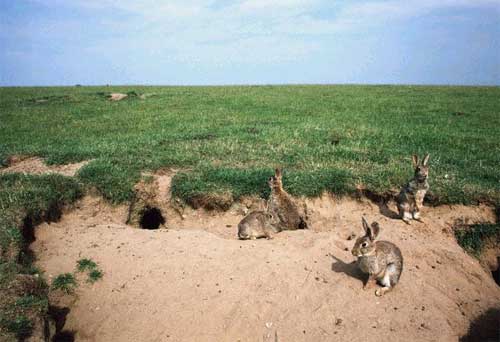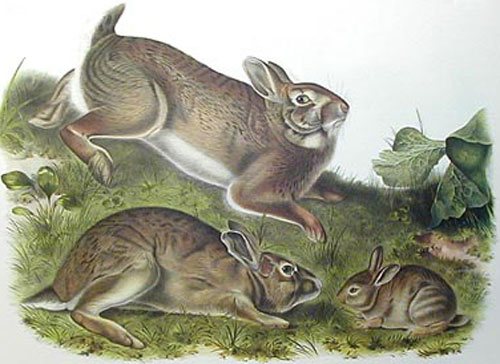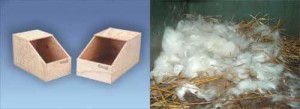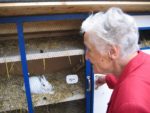Backyard Rabbit Keeping, Part 2/15 – Rabbits Past and Present
The rabbit was originally a Mediterranean animal; possibly Spain was its home. It lived in a warm dry climate and it still prefers these sort of conditions. Wild rabbits seem to be able to withstand drought better than cold weather, and backyard rabbits appreciate a warm dry hutch with no draughts.
It is thought that the rabbit may have moved up into northern Europe in prehistoric times, and after the Channel appeared which divided Britain from the mainland. Rabbits are not native to Britain; they may have come over the water with the Normans, who kept them in enclosures on their manors. There, they were looked after by a man called a warrener who kept away predators from the ‘coning-erth’ and perhaps gave the rabbits extra food in winter when green-stuff was scarce.
These Norman rabbits were untamed, living in a loose sort of captivity. When rabbit meat was needed for the table, the warrener went in with his ferrets and caught a few. This system, first practiced by the Romans, who kept their rabbits in a leporarium, became part of the feudal estate, like the fish ponds which were kept stocked with various kinds of fish and the columbarium where the pigeons were kept. The manor serfs and workers were not allowed to catch rabbits, pigeons or fish for their own use, although no doubt poaching was also part of the system. At this time rabbit was only for the table of the manor house. It was called ‘coney’ or ‘coning’ from the French word then used, compare the Welsh ‘cwningen‘. Later, the word rabbit was borrowed from the Dutch. In Tudor times, rabbit fur was special, and was used by the nobles to line their cloaks. Of course, rabbits escaped from their enclosures and became wild, as tame rabbits establish themselves in the wild today if they get the chance. Thus rabbits became part of the countryside, a pest in crops at times, but often the best source of meat for poor people. Until 1880, it was illegal for anyone except the owner of land or his friends, to take rabbits. Even if you were a tenant farmer, officially you had to stand by and watch the rabbits eat your corn, unable to do anything about it. Of course arrangements varied, and depended on the sort of man your landlord was.
The French peasant solved his meat problem by keeping rabbits in hutches, but the idea seems to have been slow in spreading to England. The British countryman dodged land-owners and keepers and snared his rabbits when he wanted them. The punishment was often severe – if he was caught. William Cobbett remarks in “Rural Rides” that ‘rabbit countries are the best countries for farm labourers.’ He had noticed their under-nourishment in areas of high farming, with few rabbits about. Wild rabbits flourished on poorer land, on the commons and wastes between the villages, and they seem not to have suffered from the enclosures. Hedges and spinneys, planted to enclose fields, provided cover for rabbits and it was not until the nineteenth century that rabbit catching became systematic and efficient.
After it became legal for tenants to take wild rabbits, they set to with a will. The meat and skins could now be sold openly, and on many a small farm the rabbits paid the rent. Some naturalists believe that the wholesale catching of rabbits in steel traps actually increased their numbers and brought about the over-population of rabbits which did so much damage to the countryside in the first half of the twentieth century. The theory is that the traps caught in their cruel clutches many animals, such as foxes, which would normally prey upon rabbits and keep their numbers down to a reasonable level.
During the eighteenth century we once more find mention of rabbits being “farmed” in big warrens. On light, sandy soils which were too poor to grow good crops, the farming writer William Marshall tells us that they were quite profitable. Marshall describes an estate on the Yorkshire Woods where there was an artificial warren covering 1500 acres. Before the rabbits were introduced, the whole area was fenced with a wooden pale and artificial burrows were made with an augur to shelter the rabbits until they had time to make their own holes. In winter they were fed with turnips and hay, but Marshall notes that the food was watched carefully because if it was too rich the animals would scour and die. A word of warning for all rabbit keepers! The problems associated with rich food were another reason for keeping rabbits on the poorer land.
 Rabbits from these large warrens were of course for sale rather than for home use; this was commercial rabbit keeping. When they were required, probably when the pelts were in the right condition, they were netted in large numbers. A silver-haired rabbit had been introduced to these Yorkshire warrens and the pelt of this rabbit was dressed as fur and exported, rather improbably one would have thought, to the East Indies. The ordinary gray rabbit fur was scraped off the skin and made into felt for hats; this job was done by a chiffonier. There were markets up and down the country for the sale of rabbit skins and separate ones for the sale of meat. For example, in Yorkshire the skins went to Malton and the meat to York or Hull. So it would seem that the rabbits were skinned and dressed on the farm before being sold.
Rabbits from these large warrens were of course for sale rather than for home use; this was commercial rabbit keeping. When they were required, probably when the pelts were in the right condition, they were netted in large numbers. A silver-haired rabbit had been introduced to these Yorkshire warrens and the pelt of this rabbit was dressed as fur and exported, rather improbably one would have thought, to the East Indies. The ordinary gray rabbit fur was scraped off the skin and made into felt for hats; this job was done by a chiffonier. There were markets up and down the country for the sale of rabbit skins and separate ones for the sale of meat. For example, in Yorkshire the skins went to Malton and the meat to York or Hull. So it would seem that the rabbits were skinned and dressed on the farm before being sold.
During the nineteenth century the Industrial Revolution brought a lot of country people into the towns – people who had been used to keeping animals and producing their own food. Many of them must have been unhappy in those narrow streets, but the more adaptable found a way of compensating for what they had lost. They began to keep such things as rabbits and pigeons. This was the start of the Fancy, and also a way to a good dinner.
Rabbits in hutches have been very useful to mankind. In Europe they have been quick to realize the value of rabbits in the backyard. In times of hardship this has warded off starvation, as governments have recognized. In Italy during the war it was compulsory to keep rabbits if you possibly could do so; and the Germans produced plans for breeding millions of rabbits. When Russia was short of food, rabbit-breeding stock was shipped from Britain, because rabbits were the quickest way of producing meat. In the British Isles, the backyard rabbit certainly did us well during the war, even though the only official foodstuff that could be spared for them was bran. In any emergency with a real shortage of food, the best investment would be rabbits.
 Commercial rabbit keeping is not our intention, but perhaps we should spare it a passing glance. The huge warrens were the start of commercial rabbits; Mrs Beeton tells us how the tradition was carried on in the early nineteenth century, in conditions reminiscent of the London cow keepers of that time. “Forty years ago there were in the metropolis one or two considerable feeders who, according to report, kept from 500 to 2,000 breeding does. These large establishments however have ceased to exist, and London receives the supply of tame as well as wild rabbits chiefly from the country.” So there is nothing new about factory farming and it keeps on cropping up. During the last few years rabbits have shown signs of going the same way as poultry and being commercialized to a high degree. Rabbit pellets, expensive concentrated food, have made it possible to produce meat for the table in eight weeks or so, instead of the four months that were needed thirty years ago. The modern breeds have of course played a part in this, but rabbits have not always lent themselves to intensive conditions quite so willingly as have chickens. It seems that they like individual attention, and they show signs of stress sometimes, when run in large numbers in wire cages, living on entirely processed food. However, rabbit farms are getting bigger, and most of the official advice you receive, would suggest that this is the only way to keep rabbits – that the backyarder should make his unit a small copy of factory conditions. I would like to suggest the alternative; we can go back to the older methods, with great advantage to ourselves and the rabbits.
Commercial rabbit keeping is not our intention, but perhaps we should spare it a passing glance. The huge warrens were the start of commercial rabbits; Mrs Beeton tells us how the tradition was carried on in the early nineteenth century, in conditions reminiscent of the London cow keepers of that time. “Forty years ago there were in the metropolis one or two considerable feeders who, according to report, kept from 500 to 2,000 breeding does. These large establishments however have ceased to exist, and London receives the supply of tame as well as wild rabbits chiefly from the country.” So there is nothing new about factory farming and it keeps on cropping up. During the last few years rabbits have shown signs of going the same way as poultry and being commercialized to a high degree. Rabbit pellets, expensive concentrated food, have made it possible to produce meat for the table in eight weeks or so, instead of the four months that were needed thirty years ago. The modern breeds have of course played a part in this, but rabbits have not always lent themselves to intensive conditions quite so willingly as have chickens. It seems that they like individual attention, and they show signs of stress sometimes, when run in large numbers in wire cages, living on entirely processed food. However, rabbit farms are getting bigger, and most of the official advice you receive, would suggest that this is the only way to keep rabbits – that the backyarder should make his unit a small copy of factory conditions. I would like to suggest the alternative; we can go back to the older methods, with great advantage to ourselves and the rabbits.
Commercial rabbit keeping is now run on industrial lines. For example, as with poultry and pigs, hybrids between various breeds of rabbit have been selected for size of carcass and speed of growth, and also for the size of the litter produced. Breeders producing hybrids usually sell the parent stock of bucks and does to the commercial meat producer. These animals, when mated together, will produce the hybrid offspring which fatten up so quickly. But to obtain more breeding stock, the meat producer has to go back to the supplier. He cannot usually save meat rabbits for breeding, since they may not breed true.
Again, as with pigs, the tendency now, especially with hybrids, is to use white animals – sometimes albinos – rather than the colored breeds. White flesh is more popular commercially and so are white pelts, because they can be dyed to suit the furrier’s art, and they are no problem to match. When gloves were made from our home-produced skins, we had to match the pelts very carefully to get two alike, and we needed to have plenty to choose from.
Another undesirable development in rabbit keeping, is the factory farming trend towards the use of additives in feeds. Antibiotics are often added to the ration, as are other drugs. In some establishments, a drug to prevent coccidiosis is always fed and it seems a pity that we should have to keep our animals drugged in order to make a living. There are signs, however, that the hazards of such things are becoming more evident; regulations on additives are being tightened up, and the more obvious pollution avoided.
This of course underlines the great advantage of doing things for yourself. You can produce the food rather more economically than you can buy it, because you cut out the farmer and the butcher. Also, you know that the food you eat is fresh and wholesome and has never seen a drug or supermarket. If you’re interested, watch for more detailed articles to follow in our 15 part series. Considering subscribing to our site using the RSS feed icon at the top of every page. Thanks and enjoy!
- Why Why Keep Rabbits?
- Rabbits Past and Present
- Some Basic Information
- Making a Start
- Housing
- Feeding
- Growing Crops for Rabbits
- Breeding
- Health
- Harvesting the Wild Rabbits
- The Harvest
- Using Rabbit Meat
- Fur Production
- Showing
- Angoras
Further Research:
   |





Leave a Reply